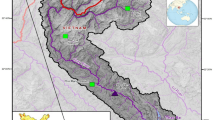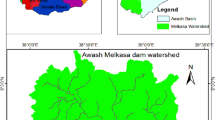Abstract
Water reservoir construction for irrigation agriculture is becoming an important strategic solution for food security. Consequently, large numbers of reservoirs have been constructed at a global scale. However, sedimentation is a prime problem. The Ribb reservoir located at the Upper Abbay Basin in the Ethiopian Northwest Highlands was designed to store 234 Mm3 of water for irrigation agriculture and is at high risk of sedimentation because of land degradation in the upstream watersheds. Hence, this study estimated runoff and sediment influx into the reservoir, established baseline elevation of the reservoir surface as a reference for temporal change analysis, and identified erosion-prone sub-watersheds for priority intervention using the SWAT model and GIS analysis. As a result, the watershed was delimited into 47 sub-watersheds, and model calibration and validation were performed using gauge station data at the watershed outlet. The watershed contribution of surface runoff, flow, and sediment yield (mean annual) to the reservoir was 267.1 mm, 13.16 m3/s, and 49 t ha−1 yr−1, respectively. The result also revealed that sub-watersheds 1, 2, 3, 7, 12, 16, 26, 29, 36, 37, and 41 were found the sources of 61% of sediment export (109.1 t ha−1 yr−1). The annual sediment production rate of the entire watershed (41.6 t ha−1 yr−1) is high. Therefore, specific and sub-watershed scale erosion and sediment management methods must be designed and implemented to minimize the runoff speed and the associated soil erosion and sediment removal to extend the reservoir life and irrigation agriculture.















Similar content being viewed by others
Data availability
Data could be available upon request of the corresponding author.
References
Abbaspour, K. C., Johnson, C. A., & van Genuchten, M. T. (2004). Estimating uncertain flow and transport parameters using a sequential uncertainty fitting procedure. Vadose Zone Journal, 3(4), 1340–1352. https://doi.org/10.2136/vzj2004.1340
Abbaspour, K. C., Yang, J., Maximov, I., Siber, R., Bogner, K., Mieleitner, J., Zobrist, J., & Srinivasan, R. (2007). Modelling hydrology and water quality in the pre-alpine/alpine Thur watershed using SWAT. Journal of Hydrology, 333, 413–430. https://doi.org/10.1016/j.jhydrol.2006.09.014
Addis, H. K., Strohmeier, S., Ziadat, F., Melaku, N. D., & Klik, A. (2016). Modeling streamflow and sediment using SWAT in Ethiopian Highlands. International Journal of Agricultural and Biological Engineering, 9(5), 51–66. https://doi.org/10.3965/j.ijabe.20160905.2483
Andualem, T. G., Guadie, A., Ahmad, I., & Dar, M. A. (2020). Hydrological modeling of Upper Ribb watershed, Abbay Basin Ethiopia. Global NEST, 22(2), 158–164. https://doi.org/10.30955/gnj.003152
Arnold, J. G., Kiniry, J. R., Srinivasan, R., & Neitsch, S. L. (2012). SWAT input/output documentation version 2012. Texas. TR-439: Texas Water Resources Institute
Arnold, J. G., Williams, J. R., & Maidment, D. R. (1995). Continuous-time water and sediment-routing model for large basins. Journal of Hydraulic Engineering, 121(2), 171–183. https://doi.org/10.1061/(ASCE)0733-9429(1995)121:2(171).
Asitatikie, A. N. (2019). Impact of land use/land cover change on hydrology of the catchment: the case of upper ribb catchment, Lake Tana Sub Basin, Ethiopia. Journal of Environment and Earth Science. https://doi.org/10.7176/JEES/9-6-02
Bezabih, A. W. (2021). Evaluation of small hydropower plant at Ribb irrigation dam in Amhara regional state. Ethiopia. Environmental System Research, 10, 1. https://doi.org/10.1186/s40068-020-00196-z
BoEPLAU. (2015). Tana sub basin integrated land use planning and environmental impact study project. Technical Report: Land use land cover and change detection. Bahir Dar, Ethiopia.
Bogale, A. (2021). Morphometric analysis of a Drainage Basin Using geographical information system in Gilgel Abay Watershed, Lake Tana Basin, Upper Blue Nile Basin Ethiopia. Applied Water Science, 11, 122. https://doi.org/10.1007/s13201-021-01447-9
Chu, T. W., & Shirmohammadi, A. (2004). Evaluation of the SWAT model’s hydrology component in the piedmont physiographic region of Maryland. American Society of Agricultural and Biological Engineers, 47(4), 1057–1073. https://doi.org/10.13031/2013.16579
Ebabu, K., Tsunekawa, A., Haregeweyn, N., Adgo, E., Meshesha, D. T., Aklog, D., Masunaga, T., Tsubo, M., Sultan, D., Fenta, A. A., & Yibeltal, M. (2019). Effects of land use and sustainable land management practices on runoff and soil loss in the Upper Blue Nile basin, Ethiopia. Science of the Total Environment, 648, 1462–1475. https://doi.org/10.1016/j.scitotenv.2018.08.273
Fenta, A. A., Tsunekawa, A., Haregeweyn, N., Poesen, J., Tsubo, M., Borrelli, P., Panagos, P., Vanmaercke, M., Broeckx, J., Yasuda, H., & Kawai, T. (2020). Land susceptibility to water and wind erosion risks in the East Africa region. Science of the Total Environment, 703, 135016.
Gashaw T, Bantider A, G/Silassie H (2014) Land degradation in ethiopia: causes, impacts and rehabilitation techniques. Journal of Environment and Earth Science, 4(9), 98–104.
Gupta, H. V., Sorooshian, S., & Yapo, P. O. (1999). Status of automatic calibration for hydrologic models: Comparison with multilevel expert calibration. Journal of Hydrologic EngIneering, 4(2), 135–143.
Hurni, H., Abate, S., Bantider, A., Debele, B., Ludi, E., Portner, B., Yitaferu, B., & Zeleke, G. (2010). Land degradation and sustainable land management in the highlands of Ethiopia. In: H. Hurni, U. Wiesmann. (Eds.), Global change and sustainable development: A synthesis of regional experiences from research partnerships. Perspectives of the Swiss National Centre of Competence in Research (NCCR) North-South, University of Bern, Geographica Bernensia, 5,187–201.
Krause, P., Boyle, D. P., & Bäse, F. (2005). Comparison of different efficiency criteria for hydrologic models. Advances in Geophysice, 5, 89–97. https://doi.org/10.5194/adgeo-5-89-2005
Lemma, H., Frankl, A., Dessie, M., Poesen, J., Adgo, E., & Nyssen, J. (2020). Consolidated sediment budget of Lake Tana, Ethiopia (2012–2016). Geomorphology, 371, 107434. https://doi.org/10.1016/j.geomorph.2020.107434
Mekonnen, M., Abeje, T., & Addisu, S. (2021). Integrated watershed management on soil quality, crop productivity and climate change adaptation, dry highland of Northeast Ethiopia. Agricultural System. https://doi.org/10.1016/j.agsy.2020.102964
Mekonnen, M., Keesstra, S. D., Ritsema, C. J., Stroosnijder, L., & Baartman, J. E. M. (2016). Sediment trapping with indigenous grass species showing differences in plant traits in northwest Ethiopia. CATENA, 147, 755–763. https://doi.org/10.1016/j.catena.2016.08.036
Moriasi, D. N., Arnold, J. G., Van Liew, M. W., Binger, R. L., Harmel, R. D., & Veith, T. (2007). Model evaluation guidelines for systematic quantification of accuracy in watershed simulations. American Society of Agricultural and Biological Engineers, 50(3), 885–900. https://doi.org/10.13031/2013.23153
MoWIE. (2010). Environmental and social impact assessment of about 20,000 ha irrigation and drainage schemes at Megech pump (seraba). Ethiopia: Ribb and anger dam.
Nash, J. E., & Sutcliffe, J. V. (1970). River flow forecasting through conceptual model. Part 1-A discussion of principles. Journal of Hydrology, 10, 282–290.
Neitsch, S. L., Arnold, J. G., Kiniry, J. R., & Williams, J. R. (2011). Soil and water assessment tool theoretical documentation version 2009. Texas: Texas Water Resource Institute.
Rientjes, T. H., Perera, J. B., Haile, A. T., Gieske, A. S., Booij, M. J., & Reggiani, P. (2011). Hydrological balance of Lake Tana, Upper Blue Nile Basin, Ethiopia. In A. M. Melesse (Ed.), Nile river basin. Dordrecht: Springer.
Setegn, S. G., Srinivasan, R., Melesse, A. M., & Dargahi, B. (2010). SWAT model application and prediction uncertainty analysis in the Lake Tana Basin Ethiopia. Hydrological Processes, 24(3), 357–367. https://doi.org/10.1002/hyp.7457
Singh, J., Knapp, H. V., & Demissie, M. (2005). Hydrologic modeling of the iroquois river watershed using HSPF and SWAT. Journal of the American Water Resources Association, 41(2), 343–360. https://doi.org/10.1111/j.1752-1688.2005.tb03740.x
Sinshaw, B. G., Belete, A. M., Tefera, A. K., Dessie, A. B., Bizuneh, B. B., Alem, H. T., Atanaw, S. B., Eshete, D. G., Wubetu, T. G., Atinkut, H. B., & Moges, M. A. (2021). Prioritization of potential soil erosion susceptibility region using fuzzy Logic and Analytical Hierarchy process, Upper Blue Nile Basin Ethiopia. Water-Energy Nexus, 4(2021), 10–24.
Teshome, A., Wale, M., Mengistu, F., & Yitaferu, B. (2009). Agricultural potentials, constraints and opportunities in the Megech and Ribb rivers irrigation project Areas in the Lake Tana Basin of Ethiopia. Bahir Dar, Ethiopia: Ethiopian Nile Irrigation and Drainage Project.
Tsegaye, L., & Bharti, R. (2022). The impacts of LULC and climate change scenarios on the hydrology and sediment yield of Rib watershed Ethiopia. Environmental Monitoring and Assessment, 194, 717. https://doi.org/10.1007/s10661-022-10391-3
USDA-SCS. (1986). Urban Hydrology for Small Watersheds, Technical Release 55. Second Edition. U.S. Dept. of Agriculture, Soil Conservation Service, Washington, D.C.
USDA-SCS. (1972). National engineering handbook. Section 4, Hydrology. U.S. Dept. of Agriculture, Soil Conservation Service, Washington, DC.
USDA-SCS. (1985). National engineering handbook. Section 4, Hydrology. U.S. Dept. of Agriculture, Soil Conservation Service, Washington, D.C.
Williams, J. R. (1975). Sediment-yield prediction with universal equation using runoff energy factor. Present and prospective technology for predicting sediment yield and sources US Department of Agriculture (pp. 244–252). Washington DC: Agriculture Research Service.
Zimale, F. A., Moges, M. A., Alemu, M. L., Ayana, E. K., Demissie, S. S., Tilahun, S. A., & Steenhuis, T. S. (2016). Calculating the sediment budget of a tropical lake in the Blue Nile basin Lake Tana. SOIL Discuss. https://doi.org/10.5194/soil-2015-84
Acknowledgments
The authors acknowledge the National Meteorological Agency of Ethiopia (NMAE) for providing rainfall data and the Ministry of Water and Irrigation of Ethiopia (MoWIE) for flow and sediment data of the study.
Funding
The authors hereby declare that no funds were obtained from any organization for this study.
Author information
Authors and Affiliations
Contributions
AA, MM, DTM, and LT were planned the study. All authors were participated in data preparation and analysis. The draft of the manuscript was written by AA and commenting, editing, and finalization were done by all the authors.
Corresponding author
Ethics declarations
Conflict of interest
The authors declare that no financial and non-financial competing interest to disclose.
Ethical approval
‘Not applicable’.
Consent to participate
‘Not applicable’.
Additional information
Communicated by XXXXXX
Publisher's Note
Springer Nature remains neutral with regard to jurisdictional claims in published maps and institutional affiliations.
Rights and permissions
Springer Nature or its licensor (e.g. a society or other partner) holds exclusive rights to this article under a publishing agreement with the author(s) or other rightsholder(s); author self-archiving of the accepted manuscript version of this article is solely governed by the terms of such publishing agreement and applicable law.
About this article
Cite this article
Ashenef, A., Mekonnen, M., Meshesha, D.T. et al. Baseline elevation and siltation of Ribb reservoir in the Upper Abbay Basin, Ethiopia: a good threshold for change detection and sustainability. J. Sediment. Environ. (2024). https://doi.org/10.1007/s43217-024-00172-y
Received:
Revised:
Accepted:
Published:
DOI: https://doi.org/10.1007/s43217-024-00172-y




